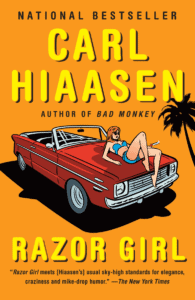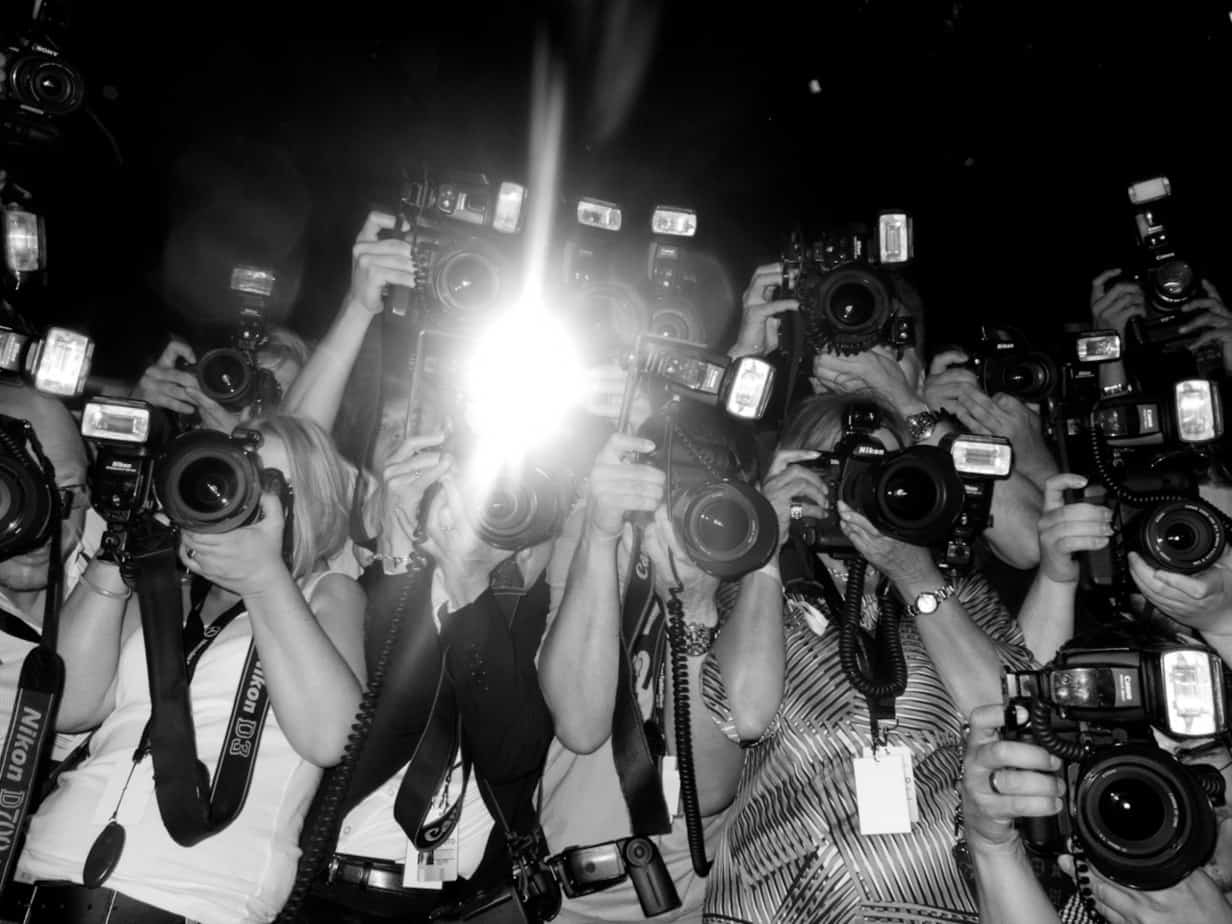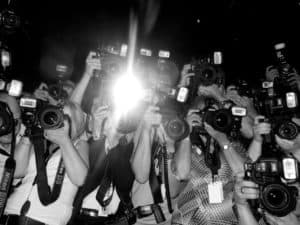
12
DecA Year in Reading
 I’ve never been big on New Year’s resolutions. I find them a little depressing, knowing I’ll likely never keep them. I don’t know what it is about the word “resolution,” but it has such a negative connotation for me that I always avoid them. I prefer to set goals. Having goals sounds way more positive to me than making resolutions. Goals are things you can work toward, resolutions are things you have to keep.
I’ve never been big on New Year’s resolutions. I find them a little depressing, knowing I’ll likely never keep them. I don’t know what it is about the word “resolution,” but it has such a negative connotation for me that I always avoid them. I prefer to set goals. Having goals sounds way more positive to me than making resolutions. Goals are things you can work toward, resolutions are things you have to keep.
I am a member of GoodReads, a social media platform centered around books and reading. When I first joined, I primarily used GoodReads as a way to keep track of the books I’ve read and the titles I wanted to read. But several years ago, GoodReads start challenging it users to a yearly reading goal in January of the new year. Participants can set the number of books they wish to finish reading by the end of December, and a member’s homepage will track their progress toward their goal. I’ve set goals every year since this feature was introduced, and mostly met them. This year, I was very ambitious and hoped to read 25 books. I might fall a few short of that goal as I’ve only read 22 and December is halfway over!
Even if I don’t finish all 25 books by January 2020, I now have a lovely record of everything I’ve read over 2019. As I look back, I can see a few trends. First of all, judging by my 5 star rating system, I’ve read a lot of fantastic books this year. I’ve also discerned a few patterns in my reading during my review. Here are a few books and reading trends I can recommend:
2019 is officially the Year of the Memoir for me. I’ve never been a nonfiction reader and rarely pick up anything but fiction. I would love to say that I purposefully started out 2019 with a desire to try new genres and expand my reading horizons, but I suspect that convenience is what led me to the memoir. The library’s popular Overdrive e-book service has a wonderful feature in its Libby app called “Available Now,” which highlights all titles that are immediately available for download. I was scrolling through this list, desperate to find an audiobook to keep me company on a long drive to New Jersey. I found Amy Poehler’s Yes, Please! and was intrigued. I’d read Tina Fey’s spectacular Bossypants years ago and figured I’d love anything Tina Fey adjacent, especially anything by Poehler, her hilarious work wife and comedic partner in crime.
Yes, Please! is comprised of short vignettes from Poehler’s life as a star on Saturday Night Live, musings on lessons in her personal life, and listicles of life advice. I love Amy Poehler but her disjointed writing along with the disclaimer at the beginning and throughout most of the book that “writing is hard” lets me know she’s not a writer. She’s a great sketch comedian but she ran out of ideas in this book and didn’t know how to string the ones she did have together. The book is filled with amazing anecdotes and guest appearances but that is the limit of its charm. The lists, advice, and many of the insights Poehler provides are somewhat boring and trite, even when read excellently by the author herself.
The two highlights of my excursion into memoir territory were Becoming, by Michelle Obama and Educated, by Tara Westover. I will be honest and say that I was sure Becoming was not worth the hype before I read it. Once I did read it, I completely understood and became part of the hype. The combination of Mrs. Obama’s raw honesty, touching memories, and no-nonsense straight talk had me devouring all 428 pages. Her ability to weave life lessons in with her story without seeming preachy was endearing and relatable, even when our lives had nothing in common. I was especially moved by her surreal and intense recollections of her time as First Lady and her determination to keep growing as a person.
Educated by Tara Westover is another amazing memoir, albeit in a completely different way. Westover narrates her dark and grim childhood struggles to survive and educate herself as a member of an off-the-grid family in rural Idaho. Her father forbids his children from attending public school, fearing any government involvement in their lives, and Tara is barely homeschooled by her mother and older siblings. She perseveres and gets into college, eventually becoming a Gates Scholar at Cambridge University. But make no mistake; this is a tough read. The book is a series of episodes illustrating the author’s terrible family experiences, with her attempts to physically escape and spiritually make sense of herself and the people she loves. Westover’s descriptions of the many accidents, injuries, and physical and psychological abuse are unflinching and horrifying. Every time she seems to find some hope of separating herself emotionally and physically from her family, she gets sucked back in. But her journey of learning what it means to be educated is not a straight line and perfectly illustrates why the struggle to be yourself is truly worth it, even at a terrible cost.
Reviewing my year in books has revealed another trend: I listen more than I read. I’ve become a real convert to audiobooks this year. Typically, I only read before going to bed. This really limits my reading time and I was frustrated by my slow progress. Audiobooks have allowed me to keep “reading” while doing other mundane tasks like running errands or folding laundry. Listening to audiobooks has also allowed me to tackle longer books than I would normally read. Finally, I’ve learned the importance of a good narrator. Someone with a good voice and ability to vocalize multiple characters is a necessity in the audiobook experience.
Pachinko, by Min Jin Lee and The Priory of the Orange Tree, by Samantha Shannon offer two different but excellent audiobook experiences. Pachinko is the multi-generational story of a Korean family that relocates to Japan in the 1930s and joins the second class citizenship of Zainichi, ethnic Koreans living in Japan. This move affects every member of the family in different ways, and some adapt better than others. Allison Hiroto is a fantastic reader, seamlessly transitioning from character to character without her performance seeming forced or clunky.
The Priory of the Orange Tree is a fantasy novel that features two interwoven narratives, one from the East and the other from the West. Each storyline faces the growing threat from the Nameless One, a terrible slumbering dragon that threatens to end life as we know it unless characters from each part of the world can work together. There are the usual suspects of a fantasy novel: assassins, dragons, and magic. But this book dispenses with the thinly veiled Puritanical ideals of most fantasy tropes and instead presents a feminist narrative that champions diversity.
Looking over my reading list from 2019 has been informative and nostalgic. I’ve read some really great books and discovered new genres. As I start to make my list for 2020, I now have a better idea of where I’ve been and where I should be headed with my reading. If you’ve never kept a reading journal or list, I highly encourage you to try it next year. You may find keeping this New Year’s resolution is easier and more fun than you think.
Kate Tigue is the Head of Youth Services at the Morrill Memorial Library in Norwood, MA. Look for her article in the December 12, 2019 issue of the Transcript and Bulletin.

5
DecCarl Hiaasen’s Florida

Carl Hiaasen wrote the little book, Assume the Worst (2018), as the “graduation speech you’ll never hear.” He wrote it to his son, Quinn, upon his commencement from high school that year. The advice as far as Hiaasen is concerned is meant for anyone. It might be a bit too honest, and perhaps a tad pessimistic, for many of us. Hiaasen argues against some of the favorite adages we hear all the time, like “Live Each Day As If It’s Your Last” and “If You Set Your Mind to It, You Can Be Anything You Want to Be.” His conflict with these sentiments? If you lived every day like it was your last, you’d undoubtedly be broke, irrelevant, and possibly in prison. And can you really be the next Willy Mays or Bill Gates? Probably not. Hiaasen’s adage? “Self-delusion is no virtue.”
Hiaasen proclaims that it’s more important to “figure out what you’re good at and get better at it.” Or, more simplistically and realistically, “live each day as if your rent is due tomorrow.”
Hiaasen has obviously taken his own advice well. He’s managed to work at what he is best at and has made the rent payments as well. Publisher Penguin-Random House interviewed Hiaasen in a “Meet the Author” episode last year, and Hiaasen admits that he is paid to “entertain and make people turn pages.”
And people have turned millions of pages in Hiaasen’s books since the late 1980s.
Carl Hiaasen was born in Florida in 1953 and has lived there all his life. He earned a journalism degree from the University of Florida four years after graduating from high school. He missed his college graduation because the small-town newspaper in Cocoa, Florida (Cocoa Today) that hired him expected him to show up to work that day.
A few years later, Hiaasen was hired to work on the Miami Herald city desk and its Sunday magazine. There he excelled at investigative journalism, exposing corruption in Florida, efforts at war with the environment, and over-development that has wounded Florida’s natural beauty. He began writing weekly columns for the Miami Herald in 1985 and continues to this day. Those columns have been published in three volumes: Kick Ass (1999), Paradise Screwed (2001), and Dance of the Reptiles (2014).
Hiaasen is most well-known outside of Florida for the novels he began writing in his spare time starting in the ’80s. The first three were co-authored with a colleague. Hiaasen struck out on his own in 1986 with Tourist Season and hasn’t stopped writing them since – he is the author of fourteen novels for adults and six for younger readers.
In 2003 he was honored with the Newbery Award for his bestselling children’s book Hoot. It was made into a family movie in 2006. His later novels for children, Flush, Scat, Chomp, and Skink-No Surrender, have been favorites among students and teachers in elementary and middle school. Nineteen of Hiaasen’s novels have been on the New York Times Best Seller lists, and many have been translated into as many as 34 languages.
I became a fan of Carl Hiaasen after reading his eighth novel, Sick Puppy, published in 2000, and I began binge-reading the earlier ones. They are irreverent and full of unsavory characters and Florida sunshine. They are a perfect recipe for fun.
Two of Hiaasen’s favorite writing tricks have managed always to tickle my fancy. One is his use of the two-word title beginning with Tourist Season through the thirteen others: Skinny Dip, Sick Puppy, Bad Monkey, Strip Tease, Stormy Weather, Nature Girl, Star Island, Double Whammy, Native Tongue, Skin Tight, Lucky You, Basket Case, and Razor Girl.
The other trick is the glorious use of real-life Florida that he finds in Floridian newspapers. If you’ve never heard of, or Googled, “Florida Man,” you haven’t discovered the never-ending litany of idiotic habits and behaviors of, well, Florida Man. As an example, Esquire Magazine listed ninety of the Wildest Florida Man Headlines from January through March 2019. January included “Florida Man Learns Hard Way He Stole Laxatives, Not Opioids.” February 6 boasts, “Florida Man Tried to Run Over Son Because He Didn’t Want to Take a Bath,” and a March 11 headline states “Florida Man Accused of Intentionally Pressure Washing His Neighbor.”
Okay, you get the picture, and funnily enough, Hiaasen admits that he uses some of these character flaws proven by newspaper accounts as the basis for events or character description in his novels.
Maybe, though, I’m drawn to Hiaasen because we have several things in common. We both graduated high school in 1970, and we both learned to write before the age of 8 on manual typewriters given to us by our fathers.
Hiaasen and I both grew up near the ocean – he on Florida’s east coast and I on California’s west coast, and we were each one of four children in our respective families. Most importantly though, we both have an unusually fine appreciation for the dark humor found in the mistakes or idiotic behavior of criminals.
Sadly, Carl Hiaasen’s only brother, Rob, was killed in a mass shooting at The Capital offices in Annapolis, in the summer of 2018. Rob followed in his older brother’s footsteps, working as an assistant editor and columnist at a city newspaper. Hiaasen was devastated by the news. Yet, he continues to write his weekly columns for the Miami Herald. He still exposes Florida corruption and disrespect for Florida’s environment, all the while ticking off many in South Florida with his honesty. Given the fact that he has continued to publish one of his novels every three or four years, I imagine he has another in the works. Certainly, there are enough real stories in Florida’s newspapers to supply characters and plot lines for more hilarity.
Charlotte Canelli is the Library Director at the Morrill Memorial Library in Norwood, MA. Look for her article in the December 5, 2019 issue of the Transcript and Bulletin.

28
NovWho’s Right About Rights?
 Imagine working at your job, at the library, police station or Town Hall, for instance, and seeing a few strangers walk in with video cameras and iPhones pointed at you. They don’t identify themselves, but ask for your name and title. They speak calmly, but decline to answer when you ask for their names and the nature of their business. In fact, they inform you that they do not need to answer, and that they have the right to film you, a public employee, and the building, a public space.
Imagine working at your job, at the library, police station or Town Hall, for instance, and seeing a few strangers walk in with video cameras and iPhones pointed at you. They don’t identify themselves, but ask for your name and title. They speak calmly, but decline to answer when you ask for their names and the nature of their business. In fact, they inform you that they do not need to answer, and that they have the right to film you, a public employee, and the building, a public space.
How do you react? Do you debate their rights and yours, or the Constitution itself? Do you demand that they stop filming, or kick them out, or threaten to call security? Do you smile or scowl? Think carefully, because all of this footage may appear on YouTube and go viral.
Nationwide and in Massachusetts, citizen journalists and activists have been conducting “First Amendment audits,” aiming to put public employees to the test, and spread awareness about the right to film, photograph and record in public spaces. They know their stuff, often better than the subjects they put on the spot, and believe it or not, the “auditors” generally operate within their rights showing up unannounced and filming employees at work.
Well-intentioned, they advocate for transparency in government, and enter public spaces blatantly recording anything in view, waiting to document whether anyone challenges their activities. The citizen journalists, quick to quote the Constitution, Bill of Rights, and the law, stand by the assertion that there is no expectation of privacy in public, the law does not require that they identify themselves or show credentials, and that freedom of the press permits them to post their videos online. Employees and agencies “pass” or “fail” audits based on how the encounters play out.
Librarians, many of us introverts by nature, dread the prospect of facing a First Amendment audit head-on. Libraries, police departments, and other municipal agencies have been acting quickly to seek counsel and develop policies in line with the law, then to inform staff of auditors’ rights and how to respond to them.
Anyone may read the Constitution and the Bill of Rights, and to better understand them we offer resources such as Akhil Amar’s The Bill of Rights Primer. With many grey areas, especially as technology advances, the actions of citizen journalists still cause controversy though. Journalism, part of the Opposing Viewpoints series, includes separate chapters on the credibility and validity of their approach. For better or worse, groups and individuals including Anonymous, Edward Snowden and WikiLeaks have exposed massive quantities of information not reported by traditional media outlets. Increasingly, loosely-affiliated individuals and groups aim to expose government infractions on a local level.
What if I don’t want someone to record me? Even “passing” an audit, I’d prefer not to appear as a poster-child for the proper response on YouTube. Or be filmed on a bad hair day! As a municipal worker, however, I may not stop someone from filming me or prevent them from uploading their footage. Where do we draw the line? Individuals may not enter “employees only” or other non-public areas in public buildings. Clearly they may not harass or threaten anyone, or prevent someone from performing their job duties (whether this entails shelving books or making an arrest). Generally though, auditors take care not to raise their voices, block doorways or engage in behavior that may rise to the level of criminal harassment. They will, on the other hand, potentially file charges against anyone who shoves them, grabs a camera, or otherwise threatens them.
What about you, the library patron, innocently using a computer or browsing the shelves? While unambiguous with regard to public servants, the law becomes hazier as applied to private citizens. While striving to gain clarity on this, I learned from the American Library Association’s Office for Intellectual Freedom (OIF) that a library is a “limited” public forum, and that ”activities such as photography, filming, petition-gathering, assemblies, and public speeches, may be regulated by the library using reasonable, viewpoint neutral, time, place, and manner rules.” Clear as mud!
We, along with the library community in general, staunchly support privacy rights. The Morrill Memorial Library does not divulge private patron information without a warrant, and takes measures to purge data no longer relevant to our record-keeping. People must have the freedom to use the public library, as stated by the OIF’s Intellectual Freedom Blog, “to receive information free from harassment, intimidation, or threats to their safety, well-being, and privacy rights.“ The good news is that First Amendment auditors of libraries don’t tend to focus on bystanders, just librarians.
The library community’s and town governments’ recommendations for responding to First Amendment audits, it turns out, seem to fulfill the activists’ main goals, to encourage transparency and educate people of their rights. After getting a crash course myself, I realized an ideal interaction involves some basic best practices for life in general: treat others as you would like to be treated, smile, de-escalate, be a good listener. If you work as a public employee, do reveal your name and position if asked, and allow anyone to film or photograph you, whether you feel camera-ready or not. Do not demand that someone answer your questions, identify themselves, or leave the premises, unless they do anything that would normally result in punitive measures (such as fighting or damaging property). Respect their command of the facts, avoiding heated debate. Smile and offer to show your visitors around and answer questions. This should warrant a passing grade, I hope.
If I ever find myself in this situation, in my capacity as a public servant or private citizen, I imagine I will very politely mention my desire not to appear online, and ask whether the crew would kindly consider this appeal. You may see me on YouTube regardless, but it doesn’t hurt to ask and say please.
Lydia Sampson is the Assistant Director at the Morrill Memorial Library in Norwood, MA. Look for her article in the November 28, 2019 issue of the Transcript and Bulletin.

21
NovThe Ties That Bond
 I never thought I’d end up marrying my former best friend’s husband.
I never thought I’d end up marrying my former best friend’s husband.
In their Halloween class picture our preschoolers are standing side-by-side dressed as Batman and a ballerina. I have photos of their son giving my youngest a bottle, and of our six kids hanging out in the hot tub at Sugarloaf while the guys played golf. Over the years my friend and I logged countless hours confiding in and commiserating with each other. When both our marriages went south, I found myself looking at Batman’s dad in a whole new light. And, evidently, vice versa.
But how to break the news to someone with whom you’ve shared everything from babies to book groups that you’re about to take sharing to a whole new level? I knew she had moved on romantically so there was no residual torch-holding, but still.
Heart pounding, I finally just blurted it out over the phone and braced for the backlash.
“That’s great, I’m so happy for you! I always thought you and Brad would be good together.” Whoa.
My parents split up when I was 13. None of my friends came from a so-called broken home so I don’t know if theirs was a typical divorce. I do know that afterwards they barely spoke to each other. At least they weren’t fighting. During our awkward, infrequent visits with Dad after he moved out, his new wife would greet me and my sister by growling “John, get the girls a drink.” (Couldn’t she?) While our stepmother wasn’t exactly wicked, she certainly wasn’t warm and fuzzy. And we never really bonded with our new half-sister.
Brad and my old friend (fondly referred to as the FW, for First Wife) have adopted a more modern approach; they occasionally email, text, and even talk. Long before he and I were invited to celebrate her second marriage–to a likable guy Brad’s brother nicknamed Buzz, as in Lightyear–I’d stopped worrying she and I would lose touch. We all get together regularly, for weddings, birthdays, baptisms, their annual Christmas party. Did I mention we used to attend the same church? Soon after Brad and I became a couple he spotted me and his first wife laughing and looking his way during coffee hour. He quipped to his fellow choir-mates, “that can’t possibly be good.”
Unlike me, the FW stayed in close contact with her former in-laws. Even after her first marriage fizzled, she and Brad’s mother remained the best of friends. The fact that his mom crocheted afghans for Buzz’s entire family was my first hint. The chummy gatherings I saw on Facebook confirmed it. As a 21-year-old bride whose parents lived overseas, the FW had eagerly embraced her new in-laws. And Brad’s mother, blessed with four boys, had been thrilled to welcome another female into the fray.
Meanwhile, Brad and Buzz high-five over backyard horseshoes and beer pong, and he and his former brother-in-law exchange pie recipes, power tools, and bad jokes. One Easter I found myself sprawled on a sofa saying “cheese” with my husband’s daughter, niece, ex-sister-in-law, and former spouse. What happened to the time-honored tradition of taking sides after a breakup? It’s all very cozy, if somewhat unconventional. As my youngest child observed, “just so you know, Mom, it’s not normal.”
Certainly not in my experience. But I’m impressed that my two long-time friends, post-divorce, have decided to bury the hatchet, not hurl it. And I know that their two adult children, who see them continue to parent, grandparent, and party together, appreciate it too.
After 13 years, Brad and I finally tied the knot. As our first anniversary approaches, my husband is about to embark on a three-week, 3000-mile transatlantic sail with my daughter Abby, her new husband, and another couple. I’ve been thinking a lot lately about blended families, new beginnings, and the unexpected twists and turns one’s life can take.
The Minuteman Library Network has an abundance of books on all the above topics, including dozens on surviving divorce emotionally, financially, and even spiritually. I was encouraged by the number of titles with a decidedly positive focus. I don’t know if Brad and the FW read any of these books, but they might have: Co-parenting 101, by Deesha Philyaw and Michael D. Thomas, or Befriending Your Ex After Divorce: Making Life Better for You, Your Kids, and Yes, Your Ex, by Judith Ruskay Rabinor.
Other resources for moving on after marriage include Connect: How to Love and Accept Yourself After Divorce, by Dawn Burnett, and Daily Meditations for Healing from Divorce: Discovering the New You, by Marlene A. Pontrelli. And although this ship has already sailed for me, I got caught up in Crazy Time: Surviving Divorce and Building a New Life, by Abigail Trafford.
Another title that drew my attention was Falling Apart in One Piece: One Optimist’s Journey through the Hell of Divorce, by the former editor in chief of Redbook magazine. When I opened the book, three beautiful postcards of Bath Abbey fell out. I regretted not having stopped in Bath with Brad on our road trip to Cornwall last spring, after Abby’s wedding in the Cotswolds, so I took it as a sign. I wasn’t going to bypass that book as well. Stacy Morrison’s story, so different from my own, was both heartbreaking and inspiring.
The FW texted me recently, excited about meeting their son’s new girlfriend, and had I read the latest Elin Hilderbrand? I wrote back right away. More than 30 years after we first met at story time at the Westwood Library, she and I are still friends, with more in common than we ever could have imagined.
April Cushing is the Head of Adult & Information Services at the Morrill Memorial Library in Norwood, MA. Look for her article in the November 21, 2019 issue of the Transcript & Bulletin.

14
NovLiving the College Dream
 Open any website, turn on any television, and you will see the latest updates regarding the SAT scandal, dubbed “Operation Varsity Blues.” According to an article by Natalie Hope McDonald, “About 50 people (including more than 30 parents) have been indicted by the U.S. Attorney in what could become the biggest bribery scandal in college history.” The story is hard to ignore because of the involvement of Hollywood stars like Felicity Huffman and Lori Loughlin, but as a mother of two teenagers, I find it upsetting on many levels.
Open any website, turn on any television, and you will see the latest updates regarding the SAT scandal, dubbed “Operation Varsity Blues.” According to an article by Natalie Hope McDonald, “About 50 people (including more than 30 parents) have been indicted by the U.S. Attorney in what could become the biggest bribery scandal in college history.” The story is hard to ignore because of the involvement of Hollywood stars like Felicity Huffman and Lori Loughlin, but as a mother of two teenagers, I find it upsetting on many levels.
For example, a slew of questions come to mind: How much pressure have we put on our kids these days? How unfair is the college admission process, economically and racially? What must students accomplish in order to get into college? Do they need perfect SAT/ACT scores? Must they start an orphanage in a faraway country to be considered by elite universities like Yale, Georgetown, Wake Forest, etc. (all of which were involved in this scandal)? Yes, as parents we want to provide the best for our children, but the best might be real life experience, not slipping a shyster a boatload of money so he can hire someone to take an achievement exam for your child.
With a senior in high school and a sophomore in college, this subject is not foreign to our family. Only a few months ago at a workshop my husband attended, the advice being doled out was “while grades and awards are important, a student needs international recognition if she wants to be noticed.” Excuse me? Did I hear that correctly? What happened to the idea of being a good student, period? Or, being a good human being, period? In this grand push for the college of one’s dreams, what is being lost along the way?
Thankfully, out there in “College Frenzy Land,” there are some voices of reason. One of my favorite education journalists is Deborah Farmer Kris. She writes about the social-emotional development of a teenager outweighing any 4.0+ report card they might achieve. In her article entitled Three Things Overscheduled Kids Need More of in Their Lives, she emphasizes the “PDF” philosophy espoused by Denise Pope, a senior lecturer at the Stanford Graduate School of Education. What’s PDF, you ask? It consists of Playtime, Downtime, and Family Time! Pope asserts these factors “protect kids against a host of negative outcomes, strengthen resilience, and bolster students’ mental wellness and academic engagement.”
Author Brennan Barnard offers some calming words of advice for college searchers as well. In his Forbes article, College Admission, Helplessness and Choice, he emphasizes that students do not have to feel helpless when looking at colleges. “The reality is that students have choice—contrary to the dominant narrative, they do have control.” He proceeds by listing some of the areas where they can assert control, such as cost (planning out what they can afford), resume building (not participating in everything under the sun), and honors classes (asking themselves “Are you genuinely excited about the classes you are taking and the degree of challenge you have elected?”) If there is a way to reduce this anxiety, Barnard would argue that road should be taken.
At the library we also have many resources. Surviving the College Application Process by Lisa Bleich is one of them. I enjoyed the case studies Bleich reveals in order to “find your unique angle for success.” Having developed her own company, College Bound Mentor, LLC, she offers guidance by using a strategic system that includes “tools to help students think about who they really are, how they learn best… and, most important, what makes them different and unique.” Each chapter is named after a student (such as Noah and Hayley and Francesca) and their personalities and answers to what they are looking for in a college prove to be insightful.
In the book Find the Perfect College for You, authors Rosalind P. Marie and C. Claire Law select 82 schools and analyze them according to the Meyers-Briggs personality indicators. For example, an Introvert studying Accounting might find Bates College more his cup of tea than Amherst College. Likewise, Robert Franek’s book, Colleges that Create Futures, looks at “50 schools that launch careers by going beyond the classroom.” You might be surprised to discover which colleges are included and why, but Northeastern University was one of them. If you find this book helpful, Franek also wrote Colleges That Pay You Back.
One of my favorite books related to this topic, however, is Where You Go Is Not Who You’ll Be, by Frank Bruni. Published in 2015 before the SAT Scandal, Bruni puts things in perspective. He argues his book is an antidote to the college admissions mania, and he’s right. A bestselling author and a columnist for the New York Times, Bruni uses “statistics, surveys and the stories of hugely successful people who didn’t attend the most exclusive schools” to show that education is what you make of it.
In many ways this leads back to the hard-learned lesson in our own family. My oldest daughter had that “dream school” in mind, like many students do. Yes, it was a stretch in some ways, but she had checked all the boxes. She had started her own origami business when she was 10-years old. She was the Valedictorian of her class. She loved Pointe and playing piano, yet she was ultimately rejected. Why? Who knows? Sometimes it feels like a crap-shoot. Maybe the college had too many Engineering applicants that year? Maybe a legacy slot had to be filled?
Needless to say, she was devastated, not just in May when she heard the news. Not just over the summer, but even as she was decorating her college dorm room where she had decided to attend. While her final decision was to attend an amazing university in the heart of Boston, it still didn’t feel like her “dream” school. And then something happened. She made a choice to enjoy where she was, and her heart begin to change. She liked being in the city. She liked her professors and the friends she was making. It turned out her new home was the best place for her, and that can be true for other students as well.
Just as the Operation Varsity Blues parents had a choice to resist the underbelly of admissions, so do we. Brennan Barnard writes, “You can choose anxiety, sleeplessness, status, fear, overscheduling, competition, doubt, and resentment or you can choose balance, joy, purpose, mindfulness, empathy, unity, collaboration, meaning, and authenticity. The power is yours—choose wisely.”
Nancy Ling is the Outreach Librarian at the Morrill Memorial Library in Norwood, MA. Look for her article in the November 14, 2019 issue of the Transcript and Bulletin.
